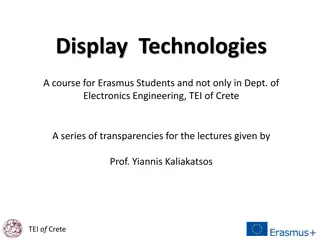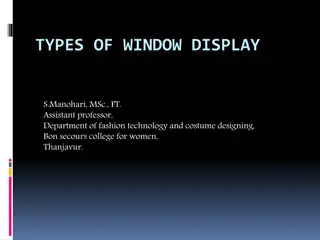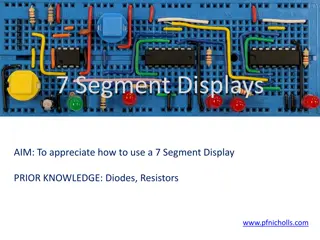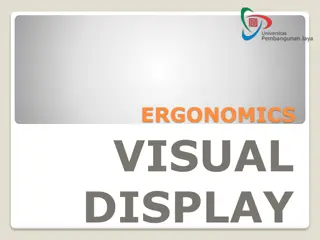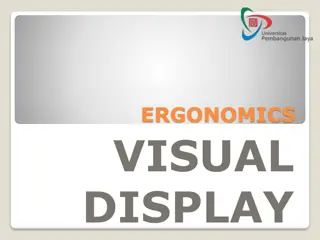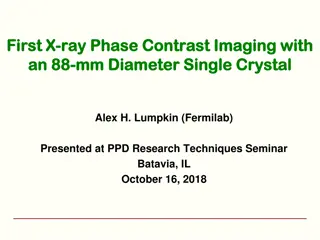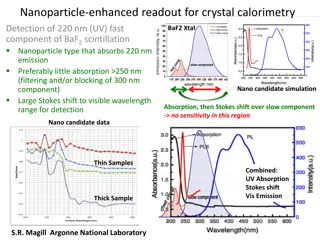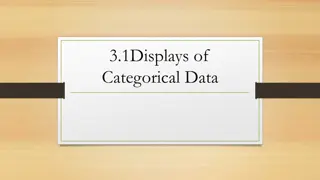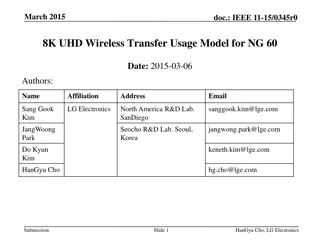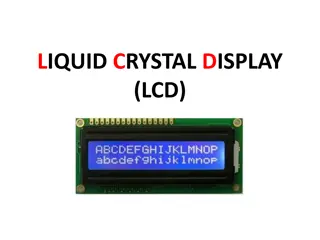Understanding Liquid Crystal Displays (LCDs) and Their Advantages
Liquid Crystal Displays (LCDs) offer advantages such as low power consumption, cost-effectiveness, and good contrast. These displays consist of liquid crystal cells sandwiched between glass sheets with transparent electrodes. The LCD relies on external illumination for visibility and uses nematic liquid crystals for twisted nematic displays. Despite drawbacks like the need for a light source and limited temperature range, LCD technology continues to be widely used in devices due to its benefits.
Download Presentation

Please find below an Image/Link to download the presentation.
The content on the website is provided AS IS for your information and personal use only. It may not be sold, licensed, or shared on other websites without obtaining consent from the author. Download presentation by click this link. If you encounter any issues during the download, it is possible that the publisher has removed the file from their server.
E N D
Presentation Transcript
The liquid-crystal display has the distinct advantage of having a lowpowerconsumption than the LED. It is typically of the order of microwatts for the display in comparison to the some order of milliwatts for LEDs. Low power consumption requirement has made it compatiblewith MOS integrated logiccircuit. Its other advantages are its low cost, and good contrast. The main drawbacks of requirement of light source, a limited temperature range of operation (between 0 and 60 C), low reliability, short operating life, poor visibility in low ambient lighting, slow speed and the need for an ac drive. LCDs are additional
A liquid crystal cell consists of a thin layer (about 10 m) of a liquid crystal sandwiched between two glass sheets with transparent electrodesdeposited on their inside faces. With both glass sheets transparent, the cell is known as transmittive type cell. When one glass is transparent and the other has a reflective coating, the cell is called reflective type. The LCD does not produce any illumination of itsown. It, in fact, depends entirely on illumination falling on it from an external source for its visual effect
Dynamic scattering display is energized, the molecules of energized area of the display become turbulent and scatterlight inall directions. Consequently, the activated areas take on a frosted glass appearance resulting in a silver display. Of course, the unenergized areas remain translucent. Field effect LCD: Field effect LCD contains front and back polarizer at right angles to each other. Without electrical excitation, the light coming through the front polarizer is rotated 90 in the fluid. scattering display: When dynamic
A translucent liquid that causes the polarization (that is, the focusing in a plane) of light waves to change as thewaves pass through the liquid. The extent of the change in polarization depends on the intensityof anapplied electric field. Nematic comes from a Greek prefix nemato meaning threadlike and is used here because the molecules in the liquid align themselves intoa threadlikeshape. Nematic liquid crystals are used in twisted nematic displays, the most common form of liquid crystal display . nematic liquid crystal is a transparent or
A twisted nematic (TN) display is a common type of liquid-crystal display ( LCD) that consists of a substance called a nematic liquid crystal that is confined between twoplatesof polarized glass. The TN display takes advantage of the ability of the nematic substance to rotate the polarization of light beams passing through it. Two polarizing filters, parallel planes of glass with their polarizing lines oriented at right angles with respect to each other, are positioned on eitherside of the liquid crystal..
When light enters the display, it is polarized by the input filter. In the absence of an electric field, all the incoming light is transmitted. This is because the light polarization is rotated 90 degrees by the nematic liquid crystal, and the light therefore passes easily through the output filter, which is oriented to match the 90-degreeshift. Most TN displays have a characteristic black-on-gray or black-on-silver appearance, and are suitable for use in alphanumeric readouts such wristwatches, cell phone displays, and some calculator displays. The high-resolution LCD panels typically found in handheld and notebook computers use a different technology. as those found in
To make an LCD, we need to take two polarized glass pieces. The glass which does not have a polarized film on it must be rubbed with a special polymer which creates microscopicgrooves in thesurface. It must also be noted that the grooves are on the samedirectionas the polarizing film. Then, we need to do is to add a coating of nematic liquid crystals to one of the filters. The grooves will cause the first layer of molecules to align with the filter sorientation.
At right angle to the first piece, we must then add a second pieceof glassalong with the polarizing film. Till the uppermost layer is at a 90-degree angle to the bottom, each successive layer of TN molecules will keepon twisting. The first filter will naturally be polarized as the light strikes itat the beginning. Thus the light passes through each layer and is guided on to the nextwith the helpof molecules.
When this happens, the molecules tend to change the plane of vibration of the light to match their own angle. When the light reaches the far side of the liquid crystal substance, it vibrates at the same angle as the final layerof molecules. The light is only allowed an entrance if the second polarized glass filter is sameas the final layer.
The main principle behind liquid crystal molecules is that when an electric current is applied to them, they tend to twist. This causes a change in the light angle passing through them. This causes a change in the angle of the top polarizing filter with respect to it. So little light is allowed topass through thatparticularareaof LCD. Thus thatarea becomesdarkercomparing toothers.
For making an LCD screen, a reflective mirror has to besetup in the back. An electrode plane made of indium-tin oxide is kept on top and a glass with a polarizing film is also added on the bottom side. The entire area of the LCD has to be covered by a common electrode and above it should be the liquid crystal substance. Next comes another piece of glass with an electrode in the shape of the rectangle on the bottom and, on top, another polarizing film. It must be noted that both of them are keptat rightangles..
When there is no current, the light passes through the front of the LCD it will be reflected by the mirror and bounced back. As the electrode is connected to a temporary battery the current from it will cause the liquid crystals between the common-plane electrode and theelectrodeshaped likearectangletountwist. Thus the light is blocked from passing through. Thus thatparticularrectangularareaappears blank







